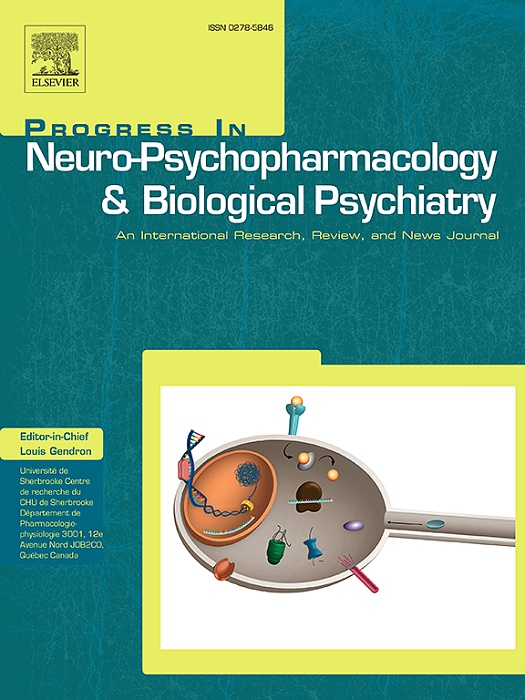大量吸食大麻的年轻人海马亚区和杏仁核体积的异常发育:一项为期三年的纵向研究
IF 5.3
2区 医学
Q1 CLINICAL NEUROLOGY
Progress in Neuro-Psychopharmacology & Biological Psychiatry
Pub Date : 2024-09-29
DOI:10.1016/j.pnpbp.2024.111156
引用次数: 0
摘要
背景:在大量吸食大麻的年轻人与未吸食大麻的年轻人之间,海马体和杏仁核的体积一直存在差异。然而,这些在功能和结构上具有异质性的区域的亚领域是否在长期大量使用大麻障碍(CUD)的年轻人身上表现出类似的变化模式,目前仍不清楚:本研究旨在探讨长期大量吸食大麻对青壮年海马和杏仁核亚区结构的影响及其纵向改变:研究样本包括 20 名大量吸食大麻的年轻人和 22 名匹配的不吸食大麻的健康志愿者。所有参与者都完成了大麻使用障碍鉴定测试(CUDIT),并接受了两次 T1 结构磁共振成像(MRI)扫描,一次是基线扫描,另一次是 3 年后的随访扫描。采用先前验证过的程序,在T1加权解剖磁共振成像扫描中对杏仁核、海马及其亚区进行了分割:与健康对照组相比,重度 CUD 患者的海马(双侧管前区、管下区、Cornu Ammonis (CA) 区 CA1、CA2-CA3 和右侧 CA4-齿状回 (DG))和杏仁核(双侧副核、右侧内侧核和右侧外侧核)亚区的体积在基线时明显增大,但这些差异在随访时有所减弱。纵向分析表明,与对照组相比,重度 CUD 青壮年患者这些亚区的体积加速缩小。特别是,与健康对照组相比,右侧海马亚区的副钟面、亚钟面和CA4-DG的体积明显加速缩小。在杏仁核中,左侧中央核、右侧旁核、右侧基底核和右侧附属基底核也观察到类似的体积加速缩小趋势:目前的研究结果表明,长期大量吸食大麻会影响杏仁核和海马的成熟过程,尤其是在大麻素 1 型受体(CB1R)浓度较高且参与成年神经发生的亚区域。本文章由计算机程序翻译,如有差异,请以英文原文为准。
Abnormal developmental of hippocampal subfields and amygdalar subnuclei volumes in young adults with heavy cannabis use: A three-year longitudinal study
Background
Differences in the volumes of the hippocampus and amygdala have consistently been observed between young adults with heavy cannabis use relative to their non-using counterparts. However, it remains unclear whether the subfields of these functionally and structurally heterogenous regions exhibit similar patterns of change in young adults with long-term heavy cannabis use disorder (CUD).
Objectives
This study aims to investigate the effects of long-term heavy cannabis use in young adults on the subregional structures of the hippocampus and amygdala, as well as their longitudinal alterations.
Methods
The study sample comprised 20 young adults with heavy cannabis use and 22 matched non-cannabis using healthy volunteers. All participants completed the Cannabis Use Disorder Identification Test (CUDIT) and underwent two T1-structural magnetic resonance imaging (MRI) scans, one at baseline and another at follow-up 3 years later. The amygdala, hippocampus, and their subregions were segmented on T1-weighted anatomical MRI scans, using a previously validated procedure.
Results
At baseline, young adults with heavy CUD exhibited significantly larger volumes in several hippocampal (bilateral presubiculum, subiculum, Cornu Ammonis (CA) regions CA1, CA2-CA3, and right CA4-Dentate Gyrus (DG)) and amygdala (bilateral paralaminar nuclei, right medial nucleus, and right lateral nucleus) subregions compared to healthy controls, but these differences were attenuated at follow-up. Longitudinal analysis revealed an accelerated volumetric decrease in these subregions in young adults with heavy CUD relative to controls. Particularly, compared to healthy controls, significant accelerated volume decreases were observed in the right hippocampal subfields of the parasubiculum, subiculum, and CA4-DG. In the amygdala, similar trends of accelerated volumetric decreases were observed in the left central nucleus, right paralaminar nucleus, right basal nucleus, and right accessory basal nucleus.
Conclusions
The current findings suggest that long-term heavy cannabis use impacts maturational process of the amygdala and hippocampus, especially in subregions with high concentrations of cannabinoid type 1 receptors (CB1Rs) and involvement in adult neurogenesis.
求助全文
通过发布文献求助,成功后即可免费获取论文全文。
去求助
来源期刊
CiteScore
12.00
自引率
1.80%
发文量
153
审稿时长
56 days
期刊介绍:
Progress in Neuro-Psychopharmacology & Biological Psychiatry is an international and multidisciplinary journal which aims to ensure the rapid publication of authoritative reviews and research papers dealing with experimental and clinical aspects of neuro-psychopharmacology and biological psychiatry. Issues of the journal are regularly devoted wholly in or in part to a topical subject.
Progress in Neuro-Psychopharmacology & Biological Psychiatry does not publish work on the actions of biological extracts unless the pharmacological active molecular substrate and/or specific receptor binding properties of the extract compounds are elucidated.

 求助内容:
求助内容: 应助结果提醒方式:
应助结果提醒方式:


